Managing Employee Relations: Challenges and Solutions at VTI Group
VerifiedAdded on 2020/03/16
|19
|4388
|465
Report
AI Summary
This report provides a comprehensive analysis of employee relations management at VTI Group, a car sales and rental company in Melbourne, Australia. The report begins with an overview of VTI Group's strategic and operational plans, including its shift from car rentals to sales of premium vehicles. It then delves into communication objectives and strategies, including verbal, written, face-to-face, and non-verbal communication methods, tailored for different audiences such as customers, employees, and management. The report also examines employee consultation processes, covering workplace health and safety, pay, communication, and diversity issues. A detailed grievance procedure is presented, outlining the steps for employees to voice complaints and the company's responsibilities. Furthermore, the report analyzes specific scenarios, addressing workplace diversity policies, conflict resolution, and communication challenges within teams. The report provides recommendations for improving employee relations, including promoting respect for differences, encouraging interaction, and implementing effective communication strategies to foster a positive and productive work environment. It also suggests that the diversity policy be monitored every three months to ensure its effectiveness. Finally, the report concludes by summarizing the key findings and recommendations for VTI Group.
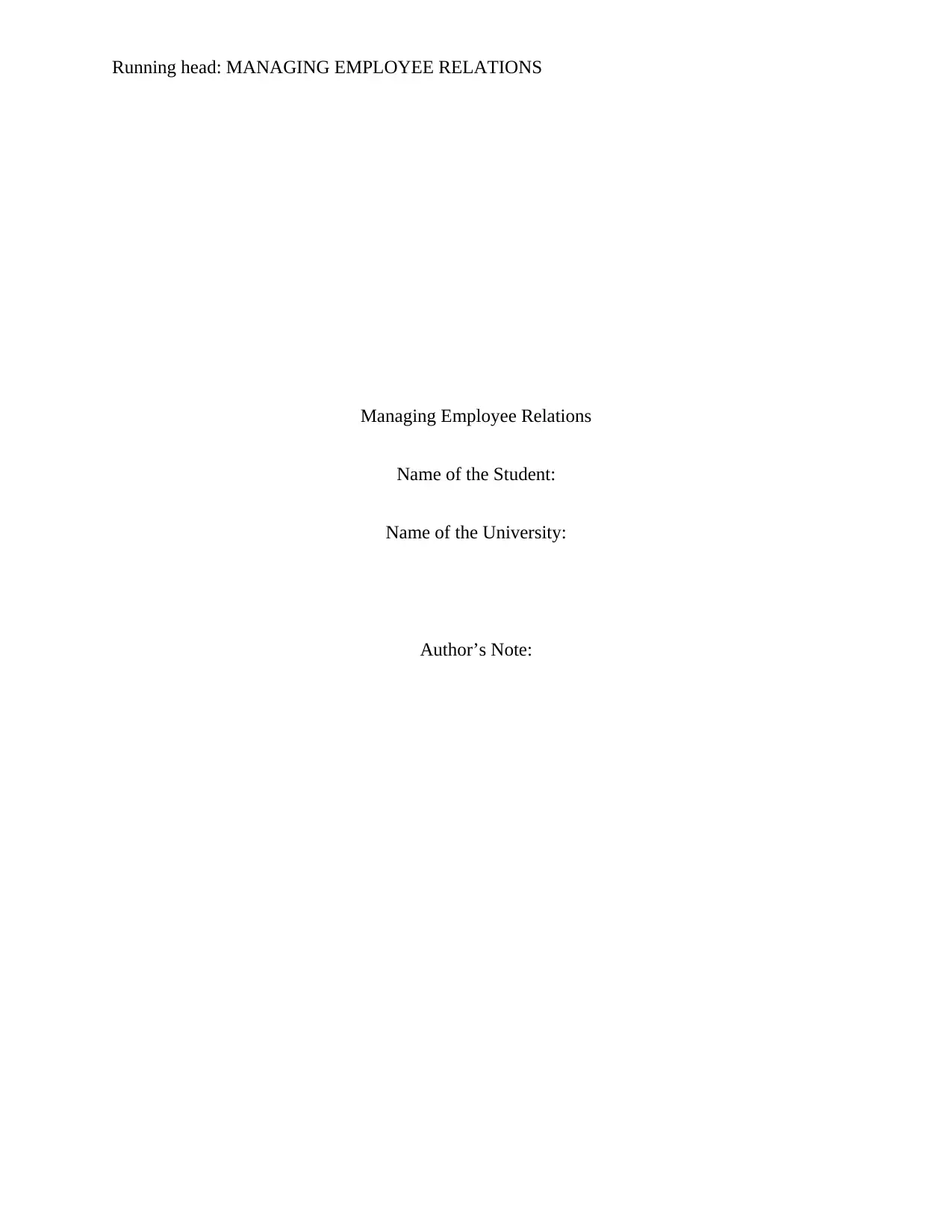
Running head: MANAGING EMPLOYEE RELATIONS
Managing Employee Relations
Name of the Student:
Name of the University:
Author’s Note:
Managing Employee Relations
Name of the Student:
Name of the University:
Author’s Note:
Paraphrase This Document
Need a fresh take? Get an instant paraphrase of this document with our AI Paraphraser
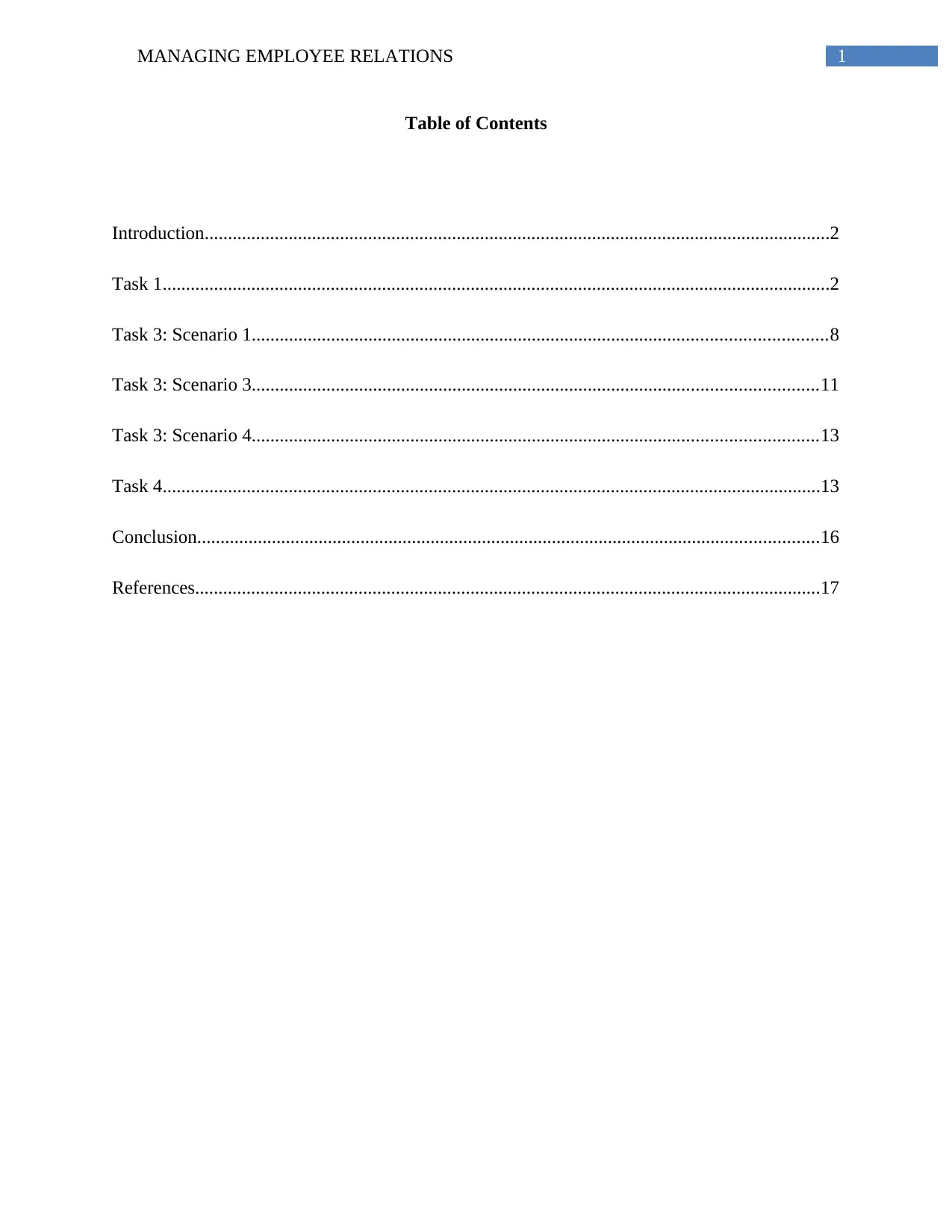
1MANAGING EMPLOYEE RELATIONS
Table of Contents
Introduction......................................................................................................................................2
Task 1...............................................................................................................................................2
Task 3: Scenario 1...........................................................................................................................8
Task 3: Scenario 3.........................................................................................................................11
Task 3: Scenario 4.........................................................................................................................13
Task 4.............................................................................................................................................13
Conclusion.....................................................................................................................................16
References......................................................................................................................................17
Table of Contents
Introduction......................................................................................................................................2
Task 1...............................................................................................................................................2
Task 3: Scenario 1...........................................................................................................................8
Task 3: Scenario 3.........................................................................................................................11
Task 3: Scenario 4.........................................................................................................................13
Task 4.............................................................................................................................................13
Conclusion.....................................................................................................................................16
References......................................................................................................................................17
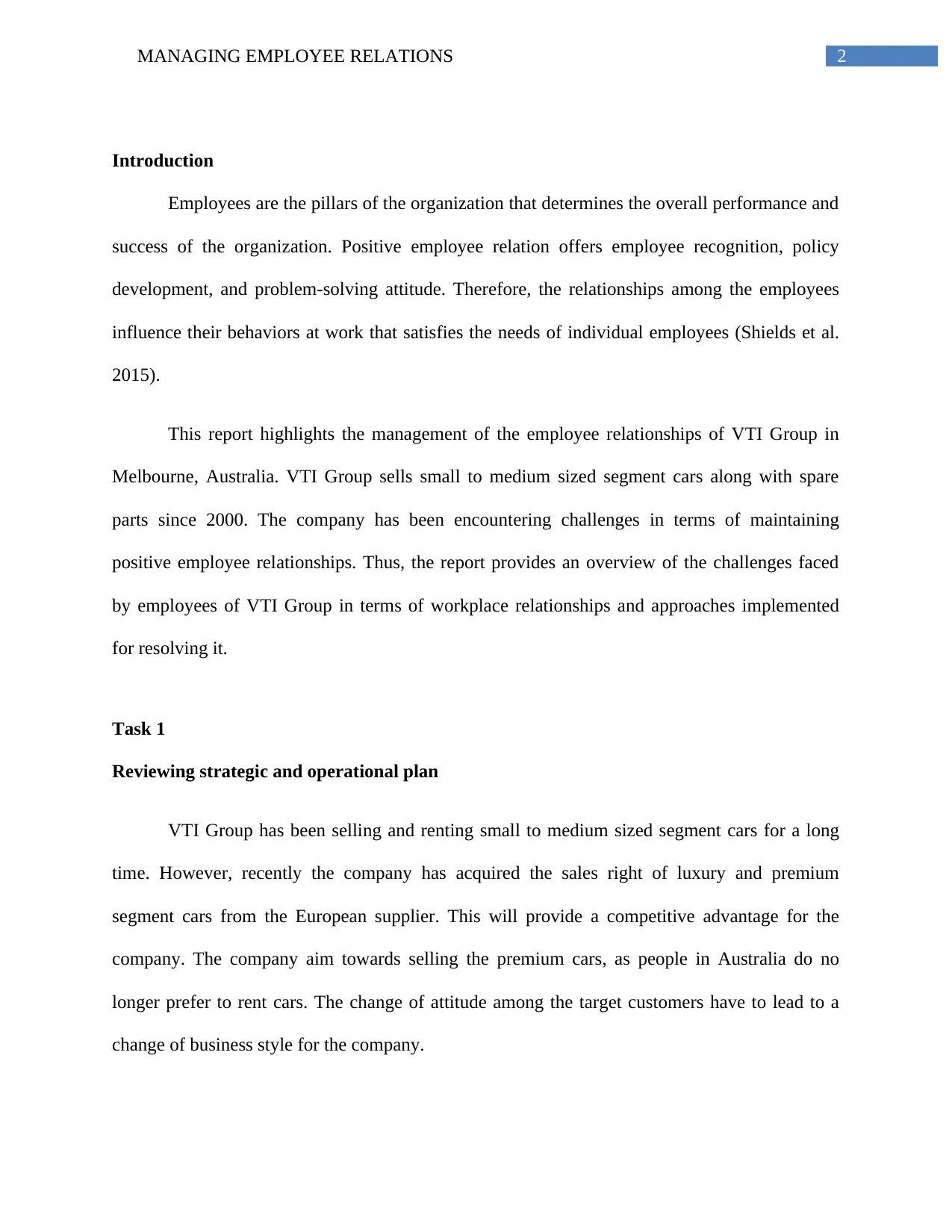
2MANAGING EMPLOYEE RELATIONS
Introduction
Employees are the pillars of the organization that determines the overall performance and
success of the organization. Positive employee relation offers employee recognition, policy
development, and problem-solving attitude. Therefore, the relationships among the employees
influence their behaviors at work that satisfies the needs of individual employees (Shields et al.
2015).
This report highlights the management of the employee relationships of VTI Group in
Melbourne, Australia. VTI Group sells small to medium sized segment cars along with spare
parts since 2000. The company has been encountering challenges in terms of maintaining
positive employee relationships. Thus, the report provides an overview of the challenges faced
by employees of VTI Group in terms of workplace relationships and approaches implemented
for resolving it.
Task 1
Reviewing strategic and operational plan
VTI Group has been selling and renting small to medium sized segment cars for a long
time. However, recently the company has acquired the sales right of luxury and premium
segment cars from the European supplier. This will provide a competitive advantage for the
company. The company aim towards selling the premium cars, as people in Australia do no
longer prefer to rent cars. The change of attitude among the target customers have to lead to a
change of business style for the company.
Introduction
Employees are the pillars of the organization that determines the overall performance and
success of the organization. Positive employee relation offers employee recognition, policy
development, and problem-solving attitude. Therefore, the relationships among the employees
influence their behaviors at work that satisfies the needs of individual employees (Shields et al.
2015).
This report highlights the management of the employee relationships of VTI Group in
Melbourne, Australia. VTI Group sells small to medium sized segment cars along with spare
parts since 2000. The company has been encountering challenges in terms of maintaining
positive employee relationships. Thus, the report provides an overview of the challenges faced
by employees of VTI Group in terms of workplace relationships and approaches implemented
for resolving it.
Task 1
Reviewing strategic and operational plan
VTI Group has been selling and renting small to medium sized segment cars for a long
time. However, recently the company has acquired the sales right of luxury and premium
segment cars from the European supplier. This will provide a competitive advantage for the
company. The company aim towards selling the premium cars, as people in Australia do no
longer prefer to rent cars. The change of attitude among the target customers have to lead to a
change of business style for the company.
⊘ This is a preview!⊘
Do you want full access?
Subscribe today to unlock all pages.

Trusted by 1+ million students worldwide
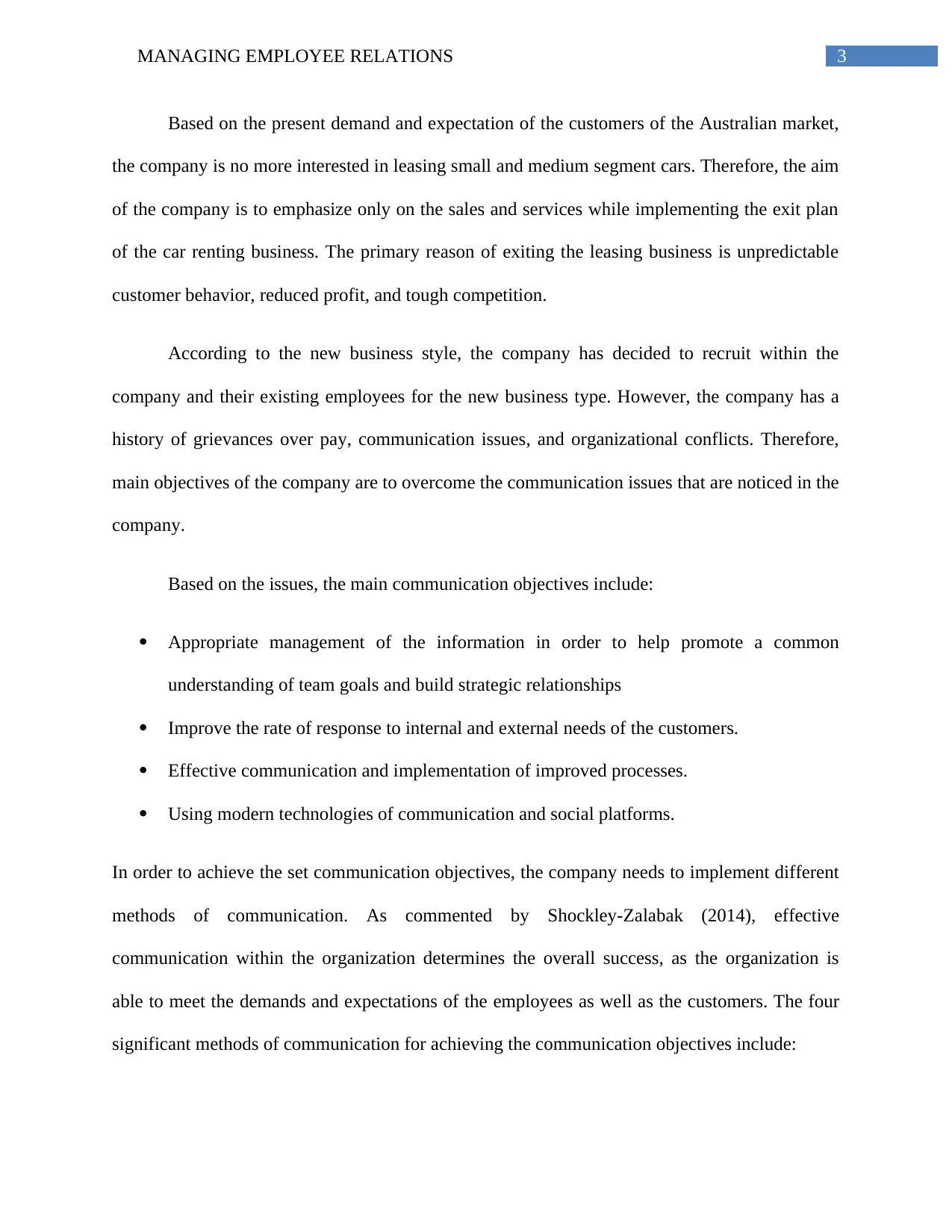
3MANAGING EMPLOYEE RELATIONS
Based on the present demand and expectation of the customers of the Australian market,
the company is no more interested in leasing small and medium segment cars. Therefore, the aim
of the company is to emphasize only on the sales and services while implementing the exit plan
of the car renting business. The primary reason of exiting the leasing business is unpredictable
customer behavior, reduced profit, and tough competition.
According to the new business style, the company has decided to recruit within the
company and their existing employees for the new business type. However, the company has a
history of grievances over pay, communication issues, and organizational conflicts. Therefore,
main objectives of the company are to overcome the communication issues that are noticed in the
company.
Based on the issues, the main communication objectives include:
Appropriate management of the information in order to help promote a common
understanding of team goals and build strategic relationships
Improve the rate of response to internal and external needs of the customers.
Effective communication and implementation of improved processes.
Using modern technologies of communication and social platforms.
In order to achieve the set communication objectives, the company needs to implement different
methods of communication. As commented by Shockley-Zalabak (2014), effective
communication within the organization determines the overall success, as the organization is
able to meet the demands and expectations of the employees as well as the customers. The four
significant methods of communication for achieving the communication objectives include:
Based on the present demand and expectation of the customers of the Australian market,
the company is no more interested in leasing small and medium segment cars. Therefore, the aim
of the company is to emphasize only on the sales and services while implementing the exit plan
of the car renting business. The primary reason of exiting the leasing business is unpredictable
customer behavior, reduced profit, and tough competition.
According to the new business style, the company has decided to recruit within the
company and their existing employees for the new business type. However, the company has a
history of grievances over pay, communication issues, and organizational conflicts. Therefore,
main objectives of the company are to overcome the communication issues that are noticed in the
company.
Based on the issues, the main communication objectives include:
Appropriate management of the information in order to help promote a common
understanding of team goals and build strategic relationships
Improve the rate of response to internal and external needs of the customers.
Effective communication and implementation of improved processes.
Using modern technologies of communication and social platforms.
In order to achieve the set communication objectives, the company needs to implement different
methods of communication. As commented by Shockley-Zalabak (2014), effective
communication within the organization determines the overall success, as the organization is
able to meet the demands and expectations of the employees as well as the customers. The four
significant methods of communication for achieving the communication objectives include:
Paraphrase This Document
Need a fresh take? Get an instant paraphrase of this document with our AI Paraphraser
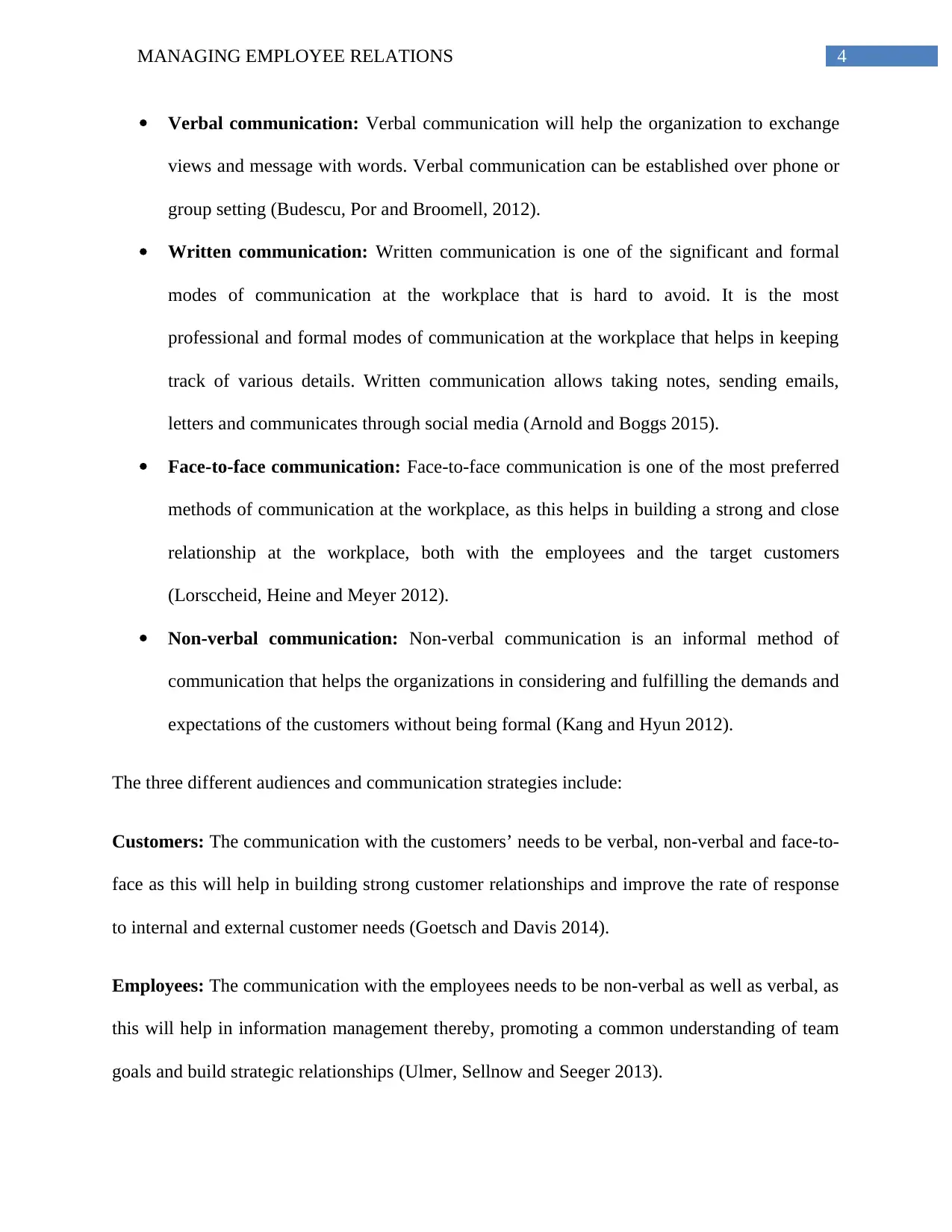
4MANAGING EMPLOYEE RELATIONS
Verbal communication: Verbal communication will help the organization to exchange
views and message with words. Verbal communication can be established over phone or
group setting (Budescu, Por and Broomell, 2012).
Written communication: Written communication is one of the significant and formal
modes of communication at the workplace that is hard to avoid. It is the most
professional and formal modes of communication at the workplace that helps in keeping
track of various details. Written communication allows taking notes, sending emails,
letters and communicates through social media (Arnold and Boggs 2015).
Face-to-face communication: Face-to-face communication is one of the most preferred
methods of communication at the workplace, as this helps in building a strong and close
relationship at the workplace, both with the employees and the target customers
(Lorsccheid, Heine and Meyer 2012).
Non-verbal communication: Non-verbal communication is an informal method of
communication that helps the organizations in considering and fulfilling the demands and
expectations of the customers without being formal (Kang and Hyun 2012).
The three different audiences and communication strategies include:
Customers: The communication with the customers’ needs to be verbal, non-verbal and face-to-
face as this will help in building strong customer relationships and improve the rate of response
to internal and external customer needs (Goetsch and Davis 2014).
Employees: The communication with the employees needs to be non-verbal as well as verbal, as
this will help in information management thereby, promoting a common understanding of team
goals and build strategic relationships (Ulmer, Sellnow and Seeger 2013).
Verbal communication: Verbal communication will help the organization to exchange
views and message with words. Verbal communication can be established over phone or
group setting (Budescu, Por and Broomell, 2012).
Written communication: Written communication is one of the significant and formal
modes of communication at the workplace that is hard to avoid. It is the most
professional and formal modes of communication at the workplace that helps in keeping
track of various details. Written communication allows taking notes, sending emails,
letters and communicates through social media (Arnold and Boggs 2015).
Face-to-face communication: Face-to-face communication is one of the most preferred
methods of communication at the workplace, as this helps in building a strong and close
relationship at the workplace, both with the employees and the target customers
(Lorsccheid, Heine and Meyer 2012).
Non-verbal communication: Non-verbal communication is an informal method of
communication that helps the organizations in considering and fulfilling the demands and
expectations of the customers without being formal (Kang and Hyun 2012).
The three different audiences and communication strategies include:
Customers: The communication with the customers’ needs to be verbal, non-verbal and face-to-
face as this will help in building strong customer relationships and improve the rate of response
to internal and external customer needs (Goetsch and Davis 2014).
Employees: The communication with the employees needs to be non-verbal as well as verbal, as
this will help in information management thereby, promoting a common understanding of team
goals and build strategic relationships (Ulmer, Sellnow and Seeger 2013).
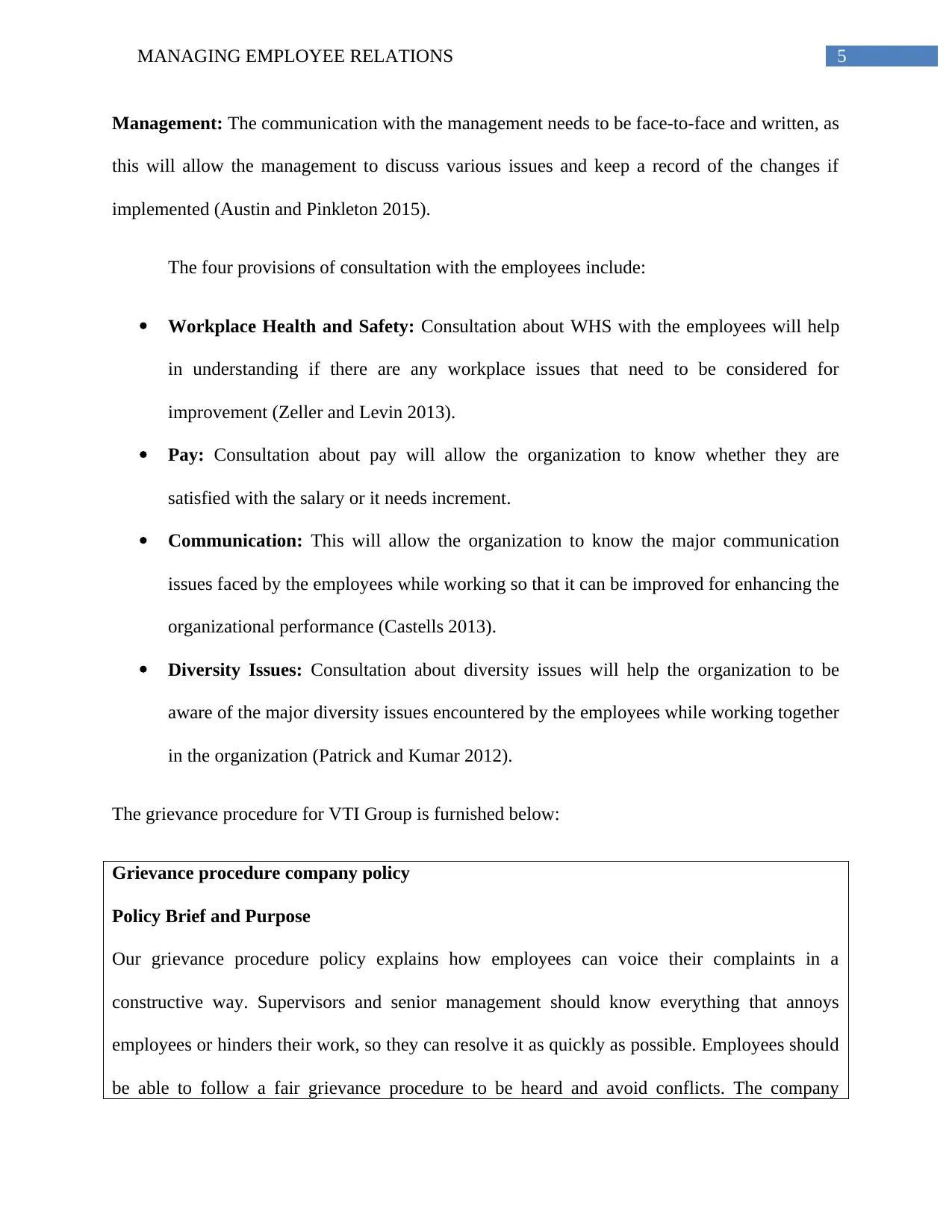
5MANAGING EMPLOYEE RELATIONS
Management: The communication with the management needs to be face-to-face and written, as
this will allow the management to discuss various issues and keep a record of the changes if
implemented (Austin and Pinkleton 2015).
The four provisions of consultation with the employees include:
Workplace Health and Safety: Consultation about WHS with the employees will help
in understanding if there are any workplace issues that need to be considered for
improvement (Zeller and Levin 2013).
Pay: Consultation about pay will allow the organization to know whether they are
satisfied with the salary or it needs increment.
Communication: This will allow the organization to know the major communication
issues faced by the employees while working so that it can be improved for enhancing the
organizational performance (Castells 2013).
Diversity Issues: Consultation about diversity issues will help the organization to be
aware of the major diversity issues encountered by the employees while working together
in the organization (Patrick and Kumar 2012).
The grievance procedure for VTI Group is furnished below:
Grievance procedure company policy
Policy Brief and Purpose
Our grievance procedure policy explains how employees can voice their complaints in a
constructive way. Supervisors and senior management should know everything that annoys
employees or hinders their work, so they can resolve it as quickly as possible. Employees should
be able to follow a fair grievance procedure to be heard and avoid conflicts. The company
Management: The communication with the management needs to be face-to-face and written, as
this will allow the management to discuss various issues and keep a record of the changes if
implemented (Austin and Pinkleton 2015).
The four provisions of consultation with the employees include:
Workplace Health and Safety: Consultation about WHS with the employees will help
in understanding if there are any workplace issues that need to be considered for
improvement (Zeller and Levin 2013).
Pay: Consultation about pay will allow the organization to know whether they are
satisfied with the salary or it needs increment.
Communication: This will allow the organization to know the major communication
issues faced by the employees while working so that it can be improved for enhancing the
organizational performance (Castells 2013).
Diversity Issues: Consultation about diversity issues will help the organization to be
aware of the major diversity issues encountered by the employees while working together
in the organization (Patrick and Kumar 2012).
The grievance procedure for VTI Group is furnished below:
Grievance procedure company policy
Policy Brief and Purpose
Our grievance procedure policy explains how employees can voice their complaints in a
constructive way. Supervisors and senior management should know everything that annoys
employees or hinders their work, so they can resolve it as quickly as possible. Employees should
be able to follow a fair grievance procedure to be heard and avoid conflicts. The company
⊘ This is a preview!⊘
Do you want full access?
Subscribe today to unlock all pages.

Trusted by 1+ million students worldwide
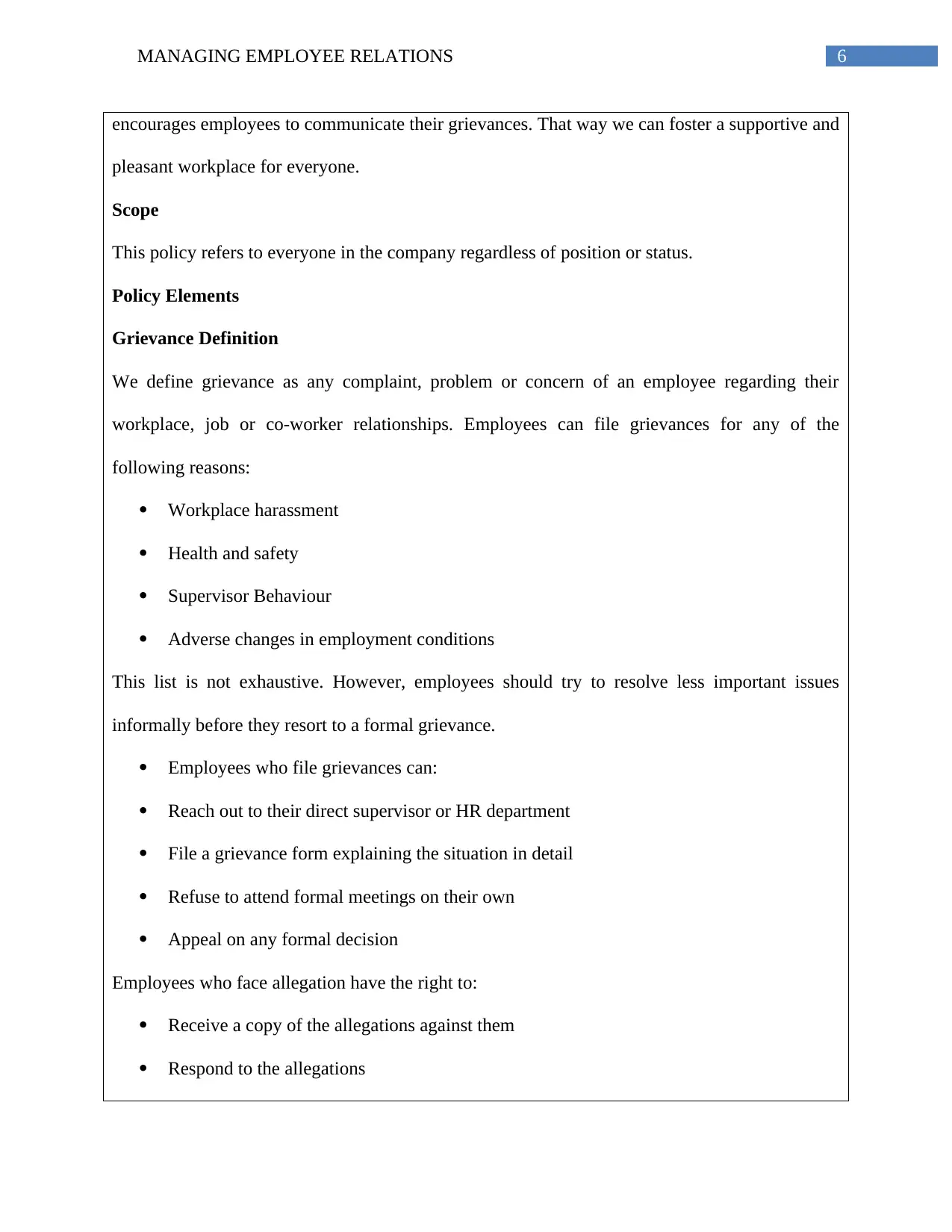
6MANAGING EMPLOYEE RELATIONS
encourages employees to communicate their grievances. That way we can foster a supportive and
pleasant workplace for everyone.
Scope
This policy refers to everyone in the company regardless of position or status.
Policy Elements
Grievance Definition
We define grievance as any complaint, problem or concern of an employee regarding their
workplace, job or co-worker relationships. Employees can file grievances for any of the
following reasons:
Workplace harassment
Health and safety
Supervisor Behaviour
Adverse changes in employment conditions
This list is not exhaustive. However, employees should try to resolve less important issues
informally before they resort to a formal grievance.
Employees who file grievances can:
Reach out to their direct supervisor or HR department
File a grievance form explaining the situation in detail
Refuse to attend formal meetings on their own
Appeal on any formal decision
Employees who face allegation have the right to:
Receive a copy of the allegations against them
Respond to the allegations
encourages employees to communicate their grievances. That way we can foster a supportive and
pleasant workplace for everyone.
Scope
This policy refers to everyone in the company regardless of position or status.
Policy Elements
Grievance Definition
We define grievance as any complaint, problem or concern of an employee regarding their
workplace, job or co-worker relationships. Employees can file grievances for any of the
following reasons:
Workplace harassment
Health and safety
Supervisor Behaviour
Adverse changes in employment conditions
This list is not exhaustive. However, employees should try to resolve less important issues
informally before they resort to a formal grievance.
Employees who file grievances can:
Reach out to their direct supervisor or HR department
File a grievance form explaining the situation in detail
Refuse to attend formal meetings on their own
Appeal on any formal decision
Employees who face allegation have the right to:
Receive a copy of the allegations against them
Respond to the allegations
Paraphrase This Document
Need a fresh take? Get an instant paraphrase of this document with our AI Paraphraser
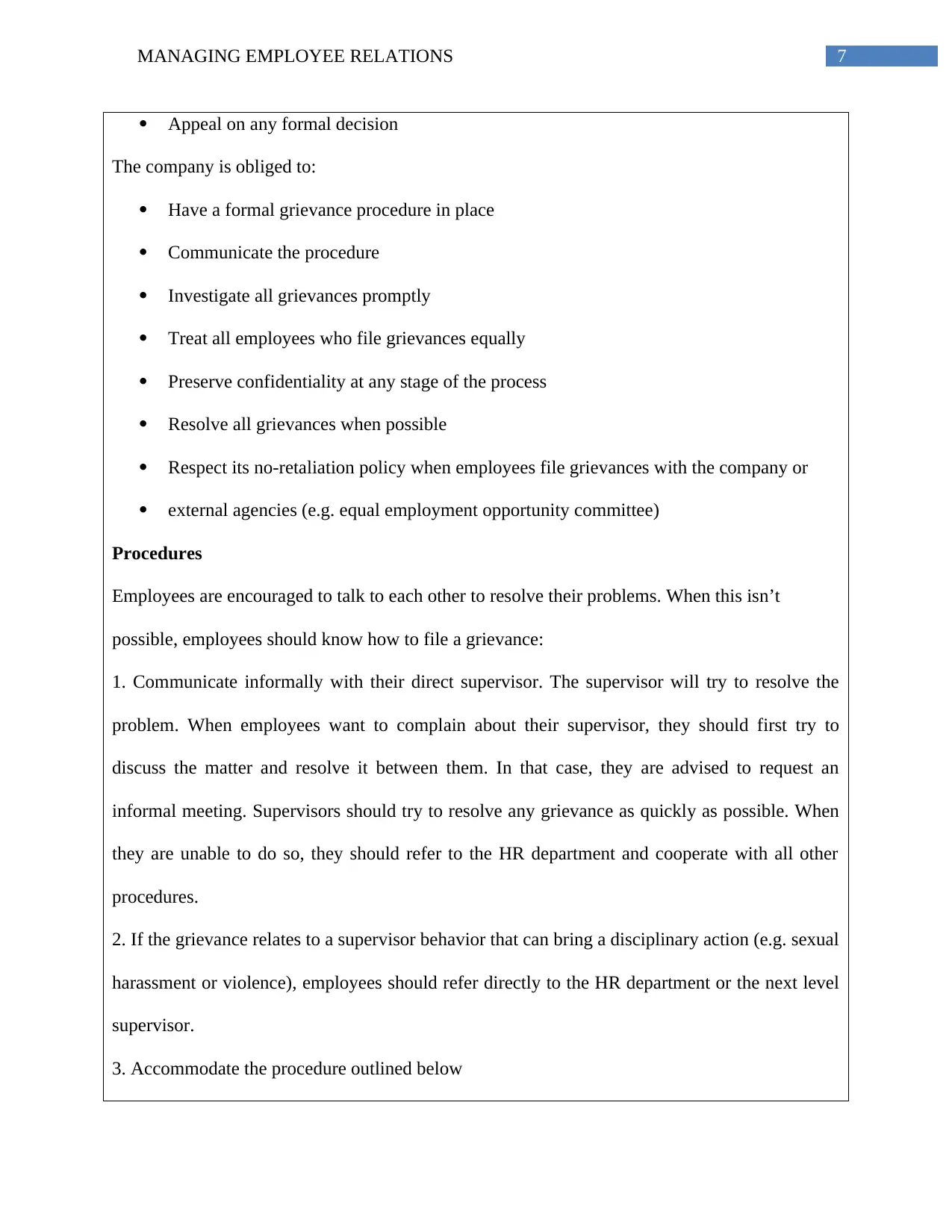
7MANAGING EMPLOYEE RELATIONS
Appeal on any formal decision
The company is obliged to:
Have a formal grievance procedure in place
Communicate the procedure
Investigate all grievances promptly
Treat all employees who file grievances equally
Preserve confidentiality at any stage of the process
Resolve all grievances when possible
Respect its no-retaliation policy when employees file grievances with the company or
external agencies (e.g. equal employment opportunity committee)
Procedures
Employees are encouraged to talk to each other to resolve their problems. When this isn’t
possible, employees should know how to file a grievance:
1. Communicate informally with their direct supervisor. The supervisor will try to resolve the
problem. When employees want to complain about their supervisor, they should first try to
discuss the matter and resolve it between them. In that case, they are advised to request an
informal meeting. Supervisors should try to resolve any grievance as quickly as possible. When
they are unable to do so, they should refer to the HR department and cooperate with all other
procedures.
2. If the grievance relates to a supervisor behavior that can bring a disciplinary action (e.g. sexual
harassment or violence), employees should refer directly to the HR department or the next level
supervisor.
3. Accommodate the procedure outlined below
Appeal on any formal decision
The company is obliged to:
Have a formal grievance procedure in place
Communicate the procedure
Investigate all grievances promptly
Treat all employees who file grievances equally
Preserve confidentiality at any stage of the process
Resolve all grievances when possible
Respect its no-retaliation policy when employees file grievances with the company or
external agencies (e.g. equal employment opportunity committee)
Procedures
Employees are encouraged to talk to each other to resolve their problems. When this isn’t
possible, employees should know how to file a grievance:
1. Communicate informally with their direct supervisor. The supervisor will try to resolve the
problem. When employees want to complain about their supervisor, they should first try to
discuss the matter and resolve it between them. In that case, they are advised to request an
informal meeting. Supervisors should try to resolve any grievance as quickly as possible. When
they are unable to do so, they should refer to the HR department and cooperate with all other
procedures.
2. If the grievance relates to a supervisor behavior that can bring a disciplinary action (e.g. sexual
harassment or violence), employees should refer directly to the HR department or the next level
supervisor.
3. Accommodate the procedure outlined below
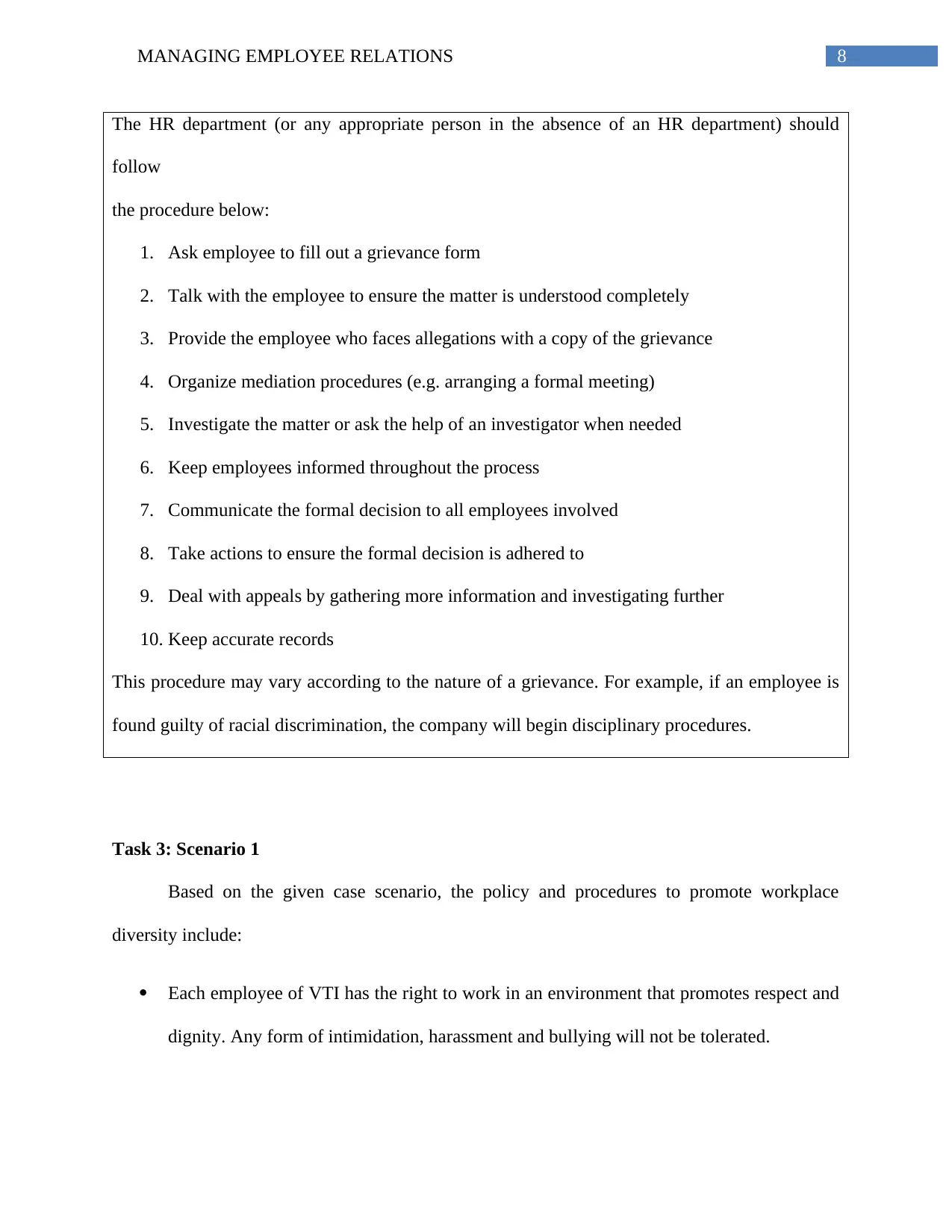
8MANAGING EMPLOYEE RELATIONS
The HR department (or any appropriate person in the absence of an HR department) should
follow
the procedure below:
1. Ask employee to fill out a grievance form
2. Talk with the employee to ensure the matter is understood completely
3. Provide the employee who faces allegations with a copy of the grievance
4. Organize mediation procedures (e.g. arranging a formal meeting)
5. Investigate the matter or ask the help of an investigator when needed
6. Keep employees informed throughout the process
7. Communicate the formal decision to all employees involved
8. Take actions to ensure the formal decision is adhered to
9. Deal with appeals by gathering more information and investigating further
10. Keep accurate records
This procedure may vary according to the nature of a grievance. For example, if an employee is
found guilty of racial discrimination, the company will begin disciplinary procedures.
Task 3: Scenario 1
Based on the given case scenario, the policy and procedures to promote workplace
diversity include:
Each employee of VTI has the right to work in an environment that promotes respect and
dignity. Any form of intimidation, harassment and bullying will not be tolerated.
The HR department (or any appropriate person in the absence of an HR department) should
follow
the procedure below:
1. Ask employee to fill out a grievance form
2. Talk with the employee to ensure the matter is understood completely
3. Provide the employee who faces allegations with a copy of the grievance
4. Organize mediation procedures (e.g. arranging a formal meeting)
5. Investigate the matter or ask the help of an investigator when needed
6. Keep employees informed throughout the process
7. Communicate the formal decision to all employees involved
8. Take actions to ensure the formal decision is adhered to
9. Deal with appeals by gathering more information and investigating further
10. Keep accurate records
This procedure may vary according to the nature of a grievance. For example, if an employee is
found guilty of racial discrimination, the company will begin disciplinary procedures.
Task 3: Scenario 1
Based on the given case scenario, the policy and procedures to promote workplace
diversity include:
Each employee of VTI has the right to work in an environment that promotes respect and
dignity. Any form of intimidation, harassment and bullying will not be tolerated.
⊘ This is a preview!⊘
Do you want full access?
Subscribe today to unlock all pages.

Trusted by 1+ million students worldwide
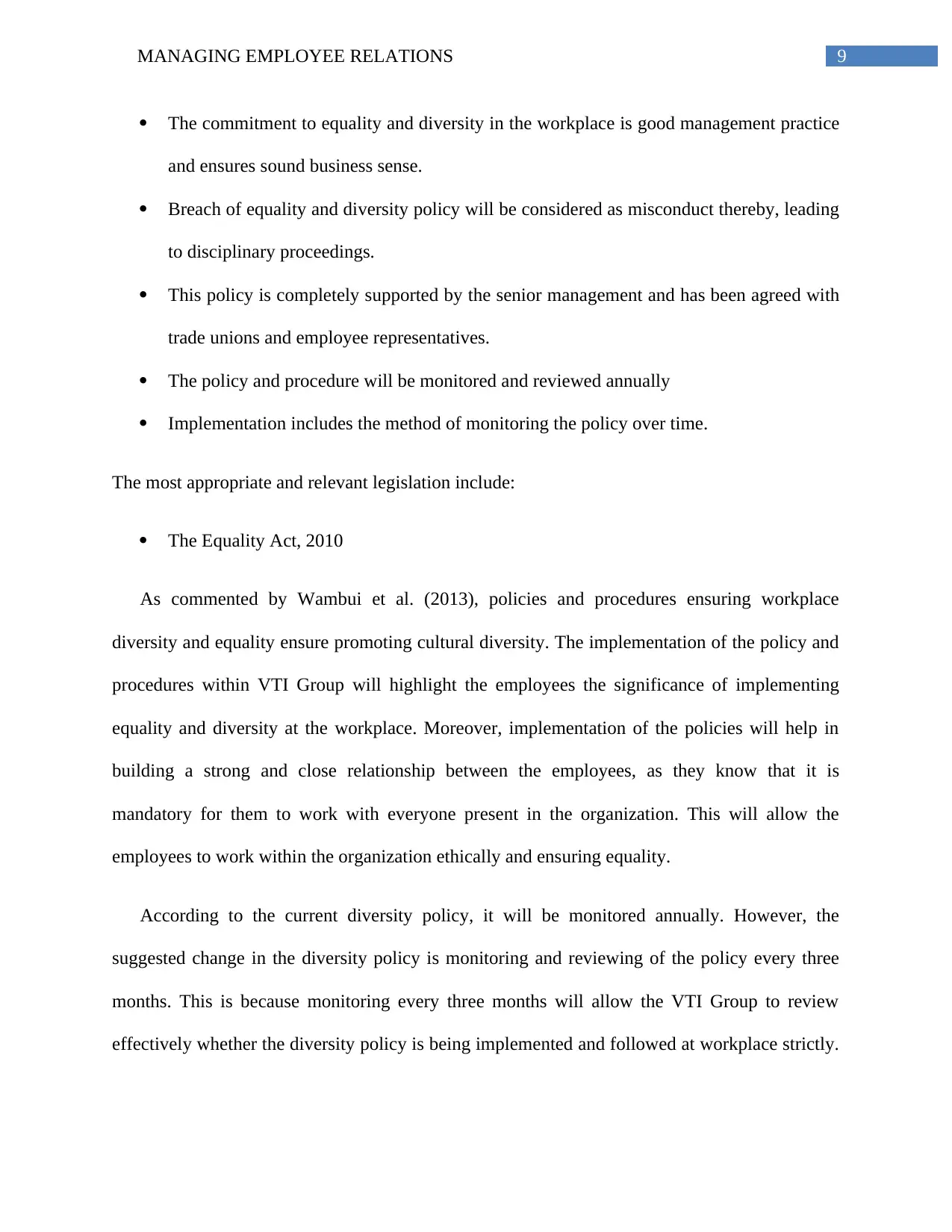
9MANAGING EMPLOYEE RELATIONS
The commitment to equality and diversity in the workplace is good management practice
and ensures sound business sense.
Breach of equality and diversity policy will be considered as misconduct thereby, leading
to disciplinary proceedings.
This policy is completely supported by the senior management and has been agreed with
trade unions and employee representatives.
The policy and procedure will be monitored and reviewed annually
Implementation includes the method of monitoring the policy over time.
The most appropriate and relevant legislation include:
The Equality Act, 2010
As commented by Wambui et al. (2013), policies and procedures ensuring workplace
diversity and equality ensure promoting cultural diversity. The implementation of the policy and
procedures within VTI Group will highlight the employees the significance of implementing
equality and diversity at the workplace. Moreover, implementation of the policies will help in
building a strong and close relationship between the employees, as they know that it is
mandatory for them to work with everyone present in the organization. This will allow the
employees to work within the organization ethically and ensuring equality.
According to the current diversity policy, it will be monitored annually. However, the
suggested change in the diversity policy is monitoring and reviewing of the policy every three
months. This is because monitoring every three months will allow the VTI Group to review
effectively whether the diversity policy is being implemented and followed at workplace strictly.
The commitment to equality and diversity in the workplace is good management practice
and ensures sound business sense.
Breach of equality and diversity policy will be considered as misconduct thereby, leading
to disciplinary proceedings.
This policy is completely supported by the senior management and has been agreed with
trade unions and employee representatives.
The policy and procedure will be monitored and reviewed annually
Implementation includes the method of monitoring the policy over time.
The most appropriate and relevant legislation include:
The Equality Act, 2010
As commented by Wambui et al. (2013), policies and procedures ensuring workplace
diversity and equality ensure promoting cultural diversity. The implementation of the policy and
procedures within VTI Group will highlight the employees the significance of implementing
equality and diversity at the workplace. Moreover, implementation of the policies will help in
building a strong and close relationship between the employees, as they know that it is
mandatory for them to work with everyone present in the organization. This will allow the
employees to work within the organization ethically and ensuring equality.
According to the current diversity policy, it will be monitored annually. However, the
suggested change in the diversity policy is monitoring and reviewing of the policy every three
months. This is because monitoring every three months will allow the VTI Group to review
effectively whether the diversity policy is being implemented and followed at workplace strictly.
Paraphrase This Document
Need a fresh take? Get an instant paraphrase of this document with our AI Paraphraser
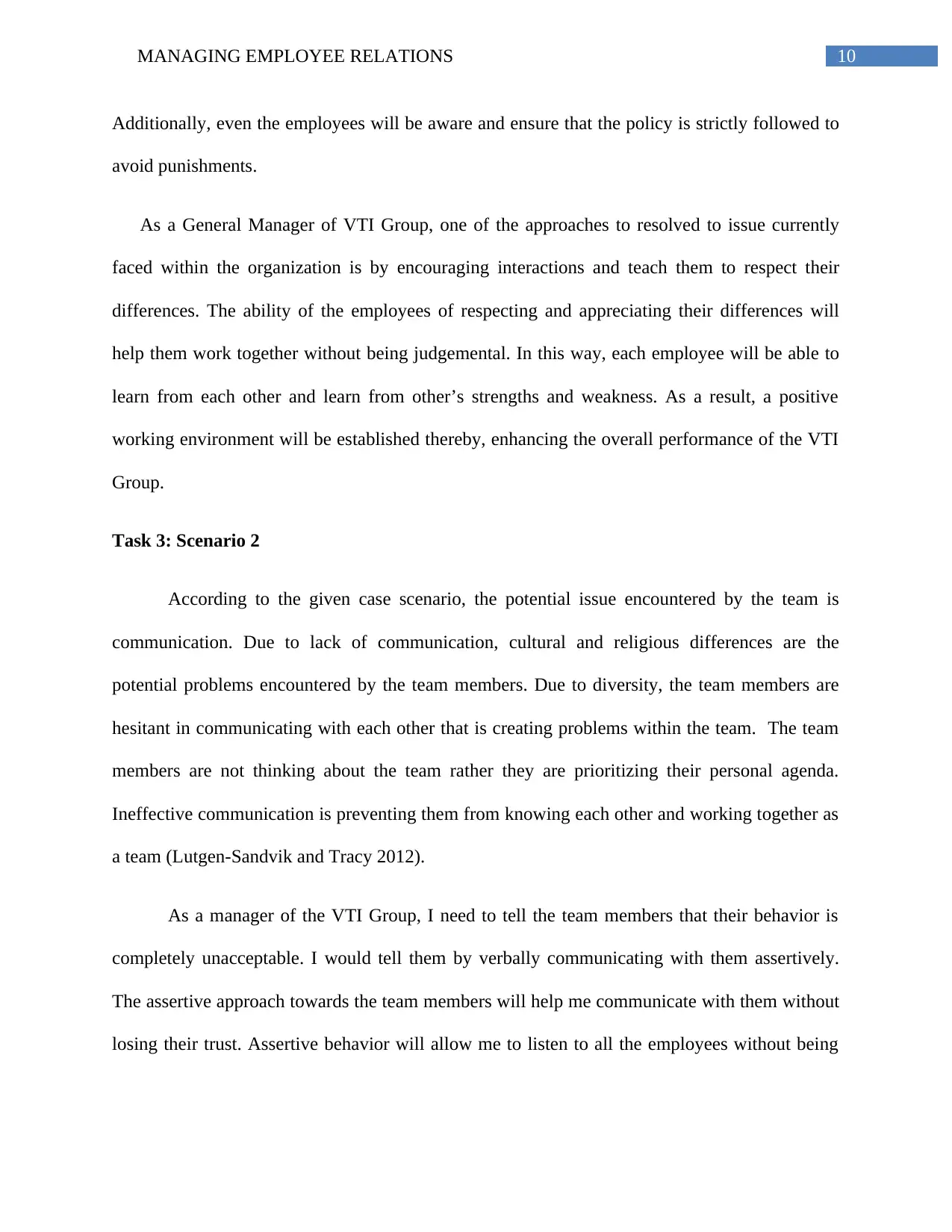
10MANAGING EMPLOYEE RELATIONS
Additionally, even the employees will be aware and ensure that the policy is strictly followed to
avoid punishments.
As a General Manager of VTI Group, one of the approaches to resolved to issue currently
faced within the organization is by encouraging interactions and teach them to respect their
differences. The ability of the employees of respecting and appreciating their differences will
help them work together without being judgemental. In this way, each employee will be able to
learn from each other and learn from other’s strengths and weakness. As a result, a positive
working environment will be established thereby, enhancing the overall performance of the VTI
Group.
Task 3: Scenario 2
According to the given case scenario, the potential issue encountered by the team is
communication. Due to lack of communication, cultural and religious differences are the
potential problems encountered by the team members. Due to diversity, the team members are
hesitant in communicating with each other that is creating problems within the team. The team
members are not thinking about the team rather they are prioritizing their personal agenda.
Ineffective communication is preventing them from knowing each other and working together as
a team (Lutgen-Sandvik and Tracy 2012).
As a manager of the VTI Group, I need to tell the team members that their behavior is
completely unacceptable. I would tell them by verbally communicating with them assertively.
The assertive approach towards the team members will help me communicate with them without
losing their trust. Assertive behavior will allow me to listen to all the employees without being
Additionally, even the employees will be aware and ensure that the policy is strictly followed to
avoid punishments.
As a General Manager of VTI Group, one of the approaches to resolved to issue currently
faced within the organization is by encouraging interactions and teach them to respect their
differences. The ability of the employees of respecting and appreciating their differences will
help them work together without being judgemental. In this way, each employee will be able to
learn from each other and learn from other’s strengths and weakness. As a result, a positive
working environment will be established thereby, enhancing the overall performance of the VTI
Group.
Task 3: Scenario 2
According to the given case scenario, the potential issue encountered by the team is
communication. Due to lack of communication, cultural and religious differences are the
potential problems encountered by the team members. Due to diversity, the team members are
hesitant in communicating with each other that is creating problems within the team. The team
members are not thinking about the team rather they are prioritizing their personal agenda.
Ineffective communication is preventing them from knowing each other and working together as
a team (Lutgen-Sandvik and Tracy 2012).
As a manager of the VTI Group, I need to tell the team members that their behavior is
completely unacceptable. I would tell them by verbally communicating with them assertively.
The assertive approach towards the team members will help me communicate with them without
losing their trust. Assertive behavior will allow me to listen to all the employees without being
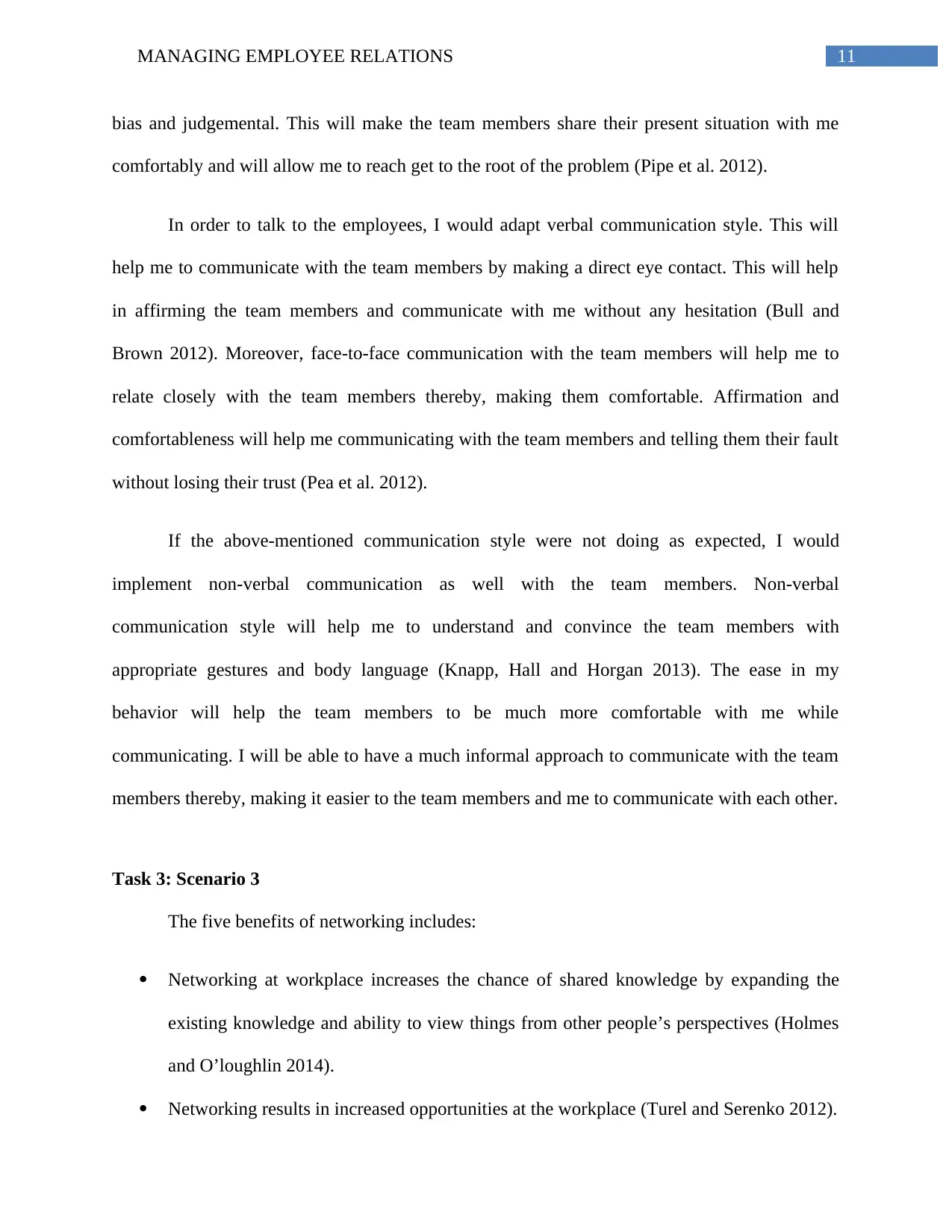
11MANAGING EMPLOYEE RELATIONS
bias and judgemental. This will make the team members share their present situation with me
comfortably and will allow me to reach get to the root of the problem (Pipe et al. 2012).
In order to talk to the employees, I would adapt verbal communication style. This will
help me to communicate with the team members by making a direct eye contact. This will help
in affirming the team members and communicate with me without any hesitation (Bull and
Brown 2012). Moreover, face-to-face communication with the team members will help me to
relate closely with the team members thereby, making them comfortable. Affirmation and
comfortableness will help me communicating with the team members and telling them their fault
without losing their trust (Pea et al. 2012).
If the above-mentioned communication style were not doing as expected, I would
implement non-verbal communication as well with the team members. Non-verbal
communication style will help me to understand and convince the team members with
appropriate gestures and body language (Knapp, Hall and Horgan 2013). The ease in my
behavior will help the team members to be much more comfortable with me while
communicating. I will be able to have a much informal approach to communicate with the team
members thereby, making it easier to the team members and me to communicate with each other.
Task 3: Scenario 3
The five benefits of networking includes:
Networking at workplace increases the chance of shared knowledge by expanding the
existing knowledge and ability to view things from other people’s perspectives (Holmes
and O’loughlin 2014).
Networking results in increased opportunities at the workplace (Turel and Serenko 2012).
bias and judgemental. This will make the team members share their present situation with me
comfortably and will allow me to reach get to the root of the problem (Pipe et al. 2012).
In order to talk to the employees, I would adapt verbal communication style. This will
help me to communicate with the team members by making a direct eye contact. This will help
in affirming the team members and communicate with me without any hesitation (Bull and
Brown 2012). Moreover, face-to-face communication with the team members will help me to
relate closely with the team members thereby, making them comfortable. Affirmation and
comfortableness will help me communicating with the team members and telling them their fault
without losing their trust (Pea et al. 2012).
If the above-mentioned communication style were not doing as expected, I would
implement non-verbal communication as well with the team members. Non-verbal
communication style will help me to understand and convince the team members with
appropriate gestures and body language (Knapp, Hall and Horgan 2013). The ease in my
behavior will help the team members to be much more comfortable with me while
communicating. I will be able to have a much informal approach to communicate with the team
members thereby, making it easier to the team members and me to communicate with each other.
Task 3: Scenario 3
The five benefits of networking includes:
Networking at workplace increases the chance of shared knowledge by expanding the
existing knowledge and ability to view things from other people’s perspectives (Holmes
and O’loughlin 2014).
Networking results in increased opportunities at the workplace (Turel and Serenko 2012).
⊘ This is a preview!⊘
Do you want full access?
Subscribe today to unlock all pages.

Trusted by 1+ million students worldwide
1 out of 19
Related Documents
Your All-in-One AI-Powered Toolkit for Academic Success.
+13062052269
info@desklib.com
Available 24*7 on WhatsApp / Email
![[object Object]](/_next/static/media/star-bottom.7253800d.svg)
Unlock your academic potential
Copyright © 2020–2025 A2Z Services. All Rights Reserved. Developed and managed by ZUCOL.





